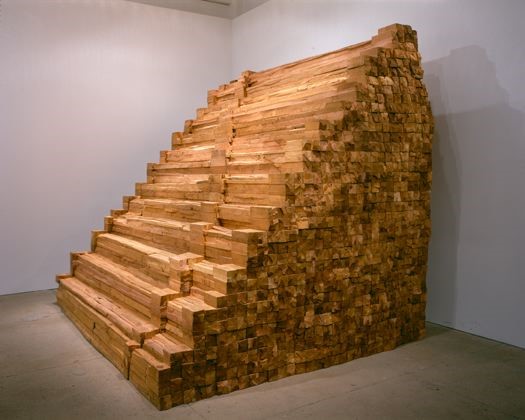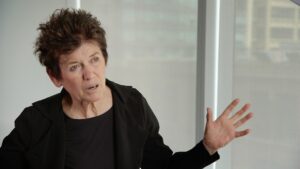Ursula von Rydingsvard’s hej-duk (2003) exists somewhere between a staircase and cliff’s edge. Its steps are coarse and irregular, and although its beams appear to be stacked systematically, the precipice tapers unevenly. The sculpture straddles the organic forms of nature and the structural logic of the human-made. Hej-duk, like many of von Rydingsvard’s pieces, reconciles the intuitive and the rational, the biotic and the synthetic.
Von Rydingsvard achieves this liminal quality through a unique method of cutting and re-working cedar. Instead of building with logs or branches, the artist uses four-by-four beams. She places one beam on the floor, draws a curving line in chalk along its edge, and cuts to the chalk’s specification. She then places a second beam alongside the first and uses its contours to inform her next incision. One by one the cedar beams are added and modified—hacked, ground, and chiseled—until the grid is reshaped into something altogether different. Embedded in this process is a double-movement: the natural contour of wood is first cut into identical units and then reworked into a single, curving formation. The organic and the constructed fold into each other, bound through alternating steps of codification and variegation.
Hej-duk’s title pays tribute to the architectural theorist John Hejduk, known for developing a building ethos that was sensitive to human experience. Like von Rydingsvard, Hejduk imagines tectonic forms in conversation with human action, describing buildings in relation to the specific feelings, stories, and events that happened within them. In Architectures in Love—a favorite of von Rydingsvard—Hejduk asks his readers, “Is it possible to make a tender architecture?”.1 Von Rydingsvard reconciles the structural and the organic in much the same way Hejduk combines the architectural and the hominal. Her constructions evoke architectural elements—a house, a room, a wall, a staircase—but their geometry is offset by hack marks that evince a human activity.
Manual labor is at the root of von Rydingsvard’s endeavor. “I think it’s extremely important for me to be working with my body, for me to be working with my hands,” von Rydingsvard told SFMOMA. Each beam registers the scoring, cleaving, and gouging of her handiwork. Even the preparatory pencil marks are left exposed. Cedar, a pliable wood, is particularly receptive to the artist’s somatic impressions—von Rydingsvard describes the wood as “sensuous.” The process of production becomes the focus of her sculptures, their grids interrupted by evidence of the artist’s hand.
Von Rydingsvard positions her work within a genealogy of manual labor. “I do come from a long line of Polish peasant farmers,” she says. “They’re still running in my blood.” The artist was born during World War II on a collective farm near the German municipality of Deensen. Her Polish mother and Ukrainian father had previously owned farmland near the Polish village of Piaseczno. Von Rydingsvard’s approach to materials reflects the ways her parents worked the fields. Groove marks in the cedar beams echo the ridges and furrows of farmland, while the shapes of her sculptures often recall shovels, rakes, and bales of hay. Hej-duk’s raw simplicity—what von Rydingsvard has described as “ruggedness” and “humbleness”—is akin to the primitive architecture of peasant farms. Even the repetitive, cyclical rhythms of her production echo those of a farmer. Hej-duk was produced piecemeal, one beam at a time, in much the same way that a field is tilled row by row and year by year.
Von Rydingsvard does not start with a blueprint; she starts with a beam of cedar. In this work, the artist becomes coextensive with her material, each guiding the other toward realization. Perhaps for this reason von Rydingsvard’s sculptures appear as if in a state of transformation, pulled and pushed between metered grid and organic relief. An architectural print by John Hejduk in SFMOMA’s collection includes the inscription, “architecture, a static thing which moves.” One could say the same for hej-duk.
Notes
- John Hejduk, Architectures in Love: Sketchbook Notes (New York: Rizzoli, 1995), n.p.


